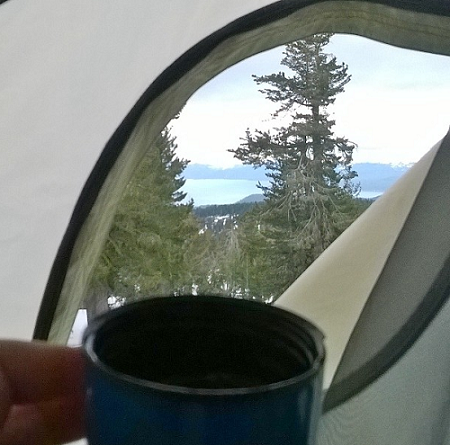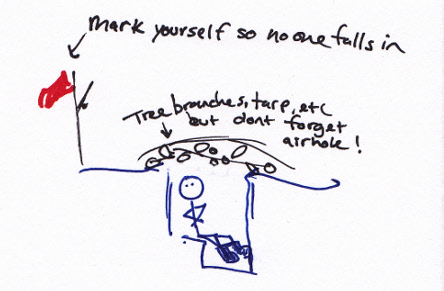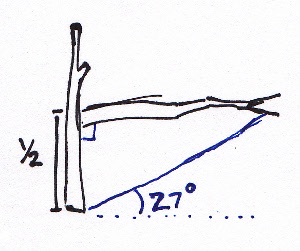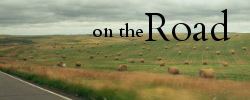
Winter Camping: Staying Warm, Safe, and Scooped!
I know, it is already spring, why all the winter? But to be fair, I attended winter camping training the day after spring officially began and we miraculously found enough snow to winter camp in during the 2015 California drought winter. Personally, I’ve had a few “Surprise” winter camping trips in the midwest – waking up under a dumping of snow in June – and while this training was geared towards have a fun, safe, and planned winter camping trip, it included lots of info that would be equally useful if you find yourself in a unexpected winter wonderland in May.
Here is an abbreviated laundry list of tips I learned while at a TRTA Snow Camping Training I attended with Trails in March.
The Basics: Staying Warm & Hydrated
Any scholar in the Maslow’s hierarchy of needs knows what you need first in any situation is water and shelter. In winter conditions ideally you already have your tent, a decent sleeping pad that separates you from the ground, sleeping bag to keep you warm, and a enough water. But if you find yourself in a real pickle:
❅ Stay dry by using layers optimally: Take off layers before getting sweaty, and put on layers before you get cold. Use all the layers! & Don’t get wet (I know, more easily said than done).
❅ Make more water from snow (but only if you packed enough fuel): Prime the pot with a thin layer water then add all the snow you want to boil, and once the water comes to a boil it is done – No need for excessive boiling here! Save fuel, which is a precious commodity and will be used up SUPER quickly in the cold weather. Trails and I ran out of fuel, but had also carried up a bunch of water (win some, loose some).

The cold shot of Folgers instant coffee I had in the morning because we had ran out of fuel. Breakfast of Champions?
❅ If all else fails, camp out the night in a quickly made coffin style Snow Trench Shelter: It doesn’t look pretty, but is the easiest to build and provides shelter without wasting too much energy. One participant at the training did this and didn’t seem too worse for the wear.

My homemade snow trench diagram. If you are in a survival situation and just need a place to hunker down the snow trench can be made just wide enough to sit until the storm is over. For a full night’s shelter the bench can be made long enough to lie down. Notice the foot trench, which helps to divert cold air down and away from the core.
The Serious Stuff: Avalanches & Hypothermia
The next layer of the hierarchy of needs is safety, and the moral of the story is really plan ahead. Know the weather, know the location, and tell a friend. But here are a couple neat tricks to keep safer in the winter:
❅ Learning to keep away from avalanche risk areas requires only basic trigonometry: Using ski poles, or even sticks, to estimate slope. With two equal length sticks hold one perpendicular to the other at the midpoint, if the tip touches the snow in front of you that means you are approaching a 27 degree or greater slope. Unless you are a pro at reading the snow (I’m not) don’t go if it is over 27 degrees. Good to know!

To Avoid Avalanches: If you hit snow, don’t go!
❅ Hypothermia is hard to spot in anyone but yourself: Know if you are thinking slowly or taking longer to perform basic tasks. If you need to assess the hypothermia risk in other hikers take into account their overall physical condition (not just how many layers they have). People with better circulation systems are more efficient at distributing heat, even in cold conditions. Basically, if stuff is getting real out there don’t be afraid to ask real questions about people’s health.
Get Scooped!: Snow Sculpting & Camp Set Up
Jumping straight to self actualization on the hierarchy of needs, snow camping has some sweet perks – like sculpting a flat tent pad into the hill, creating a countertop for cooking, and camping only a couple miles from the road without seeing anyone. I am glad I bought ‘Bluebird’, my new collapsible snow shovel, to help scoop out an awesome camp setup!

If you are interested in attending a winter camping training I would definitely recommend the ones put on by the Tahoe Rim Trail Association – the volunteer instructors were friendly, fun, experienced, and very knowledgeable. If you just want to read more ‘Let it Snow Lessons’ check out my snow camping partner in crime’s website, TrailsGuide






 Hello! I am a 30-something outdoors-lady, backpacker, and resident of Groveland, California -
Hello! I am a 30-something outdoors-lady, backpacker, and resident of Groveland, California - 


Follow Me: